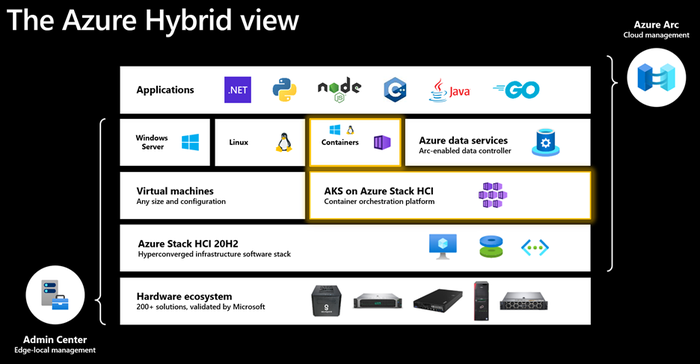Microsoft Advances Cloud-Native Solutions in Hybrid ScenariosMicrosoft Advances Cloud-Native Solutions in Hybrid Scenarios
Microsoft kicked off its annual Build conference with a focus on cloud-native apps.
May 26, 2021

MICROSOFT BUILD — Eying an accelerated shift to cloud-native solutions, Microsoft has outlined advances to its Azure infrastructure and applications. The company unveiled a flurry of releases on Tuesday at its Build conference. Among them: Its Azure Kubernetes Service on Azure Stack HCI (AKS-HCI) is now generally available.
Microsoft Build is the company’s annual event for developers. It provides a road map for Microsoft’s entire ecosystem of partners on the next wave of solutions. The theme was consistent: Microsoft’s applications for productivity, collaboration, information management, communications and industrial automation are shifting toward container-based, cloud-native software.
Likewise, Microsoft is enhancing its Azure Arc hybrid cloud infrastructure, which it designed to improve the portability of Kubernetes-based microservices and containers.
“The apps of the future will be cloud-native, and you should be able to run them anywhere across on-premises, edge and multicloud,” Microsoft CEO Satya Nadella said in opening remarks kicking off Build. The company is holding the event virtually this week.
 “Azure application services will now be able to run on Kubernetes and anywhere with Azure Arc,” Nadella said. “This means you can now run your favorite Azure application services on premises, at the edge or in other clouds.”
“Azure application services will now be able to run on Kubernetes and anywhere with Azure Arc,” Nadella said. “This means you can now run your favorite Azure application services on premises, at the edge or in other clouds.”
The general availability of AKS-HCI comes eight months after Microsoft released the first technical preview. During the period, the company added four updates to the preview.
AKS-HCI is a solution to deploy, secure and manage the life cycle of Kubernetes clusters running in data centers and edge locations. It lets developers and administrators manage cloud-native, modern apps in an “Azure-consistent manner.”
Expanded Support for Azure Application Services
Microsoft released the preview of Azure application services that can run in Kubernetes-based environments. As described by Gabe Monroy, VP of Azure developer experiences, these app services can run in Azure, on premises, as well as in AWS and Google Cloud. Microsoft is offering it through Azure Arc.
“Any Cloud Native Computing Foundation (CNCF)-conformant Kubernetes cluster connected through Azure Arc is now a supported deployment target for Azure application services,” according to Monroy. Specifically, the application services include:
Azure App Service: A managed service for building, deploying and scaling web apps.
Azure Functions: Enables simplified event-driven programming to build serverless apps.
Logic Apps: A container-based integration platform as a service (iPaaS) with a library of over 400 connectors to create automated workflows for connecting apps, data, service and backend systems.
Azure API Management: A hybrid multi-cloud platform designed to enable unified management of APIs.
Azure IoT Edge Updates
Also on the hybrid cloud front, Microsoft offered updates to its edge portfolio, Azure IoT. Among them is the general availability of nesting capabilities for Azure IoT Edge. This new update allows industrial customers to secure critical assets that require conformance with the ANSI/ISA-95 standard for network isolation.
“This IoT Edge solution adds to other significant advancements that make it easier for companies to benefit from IoT, including Azure Defender for IoT, Azure IoT Edge security enclaves, Device Update for IoT Hub, and Azure Digital Twins, according to the announcement by Microsoft partner product manager Christopher Berlin.
Microsoft’s Azure IoT Edge for Linux on Windows, code-named EFLOW, is also now generally available. Azure IoT Edge for Linux on Windows allows customers to use both Windows and Linux rather than having to choose.
Want to contact the author directly about this story? Have ideas for a follow-up article? Email Jeffrey Schwartz or connect with him on LinkedIn. |
Read more about:
MSPsAbout the Author
You May Also Like


